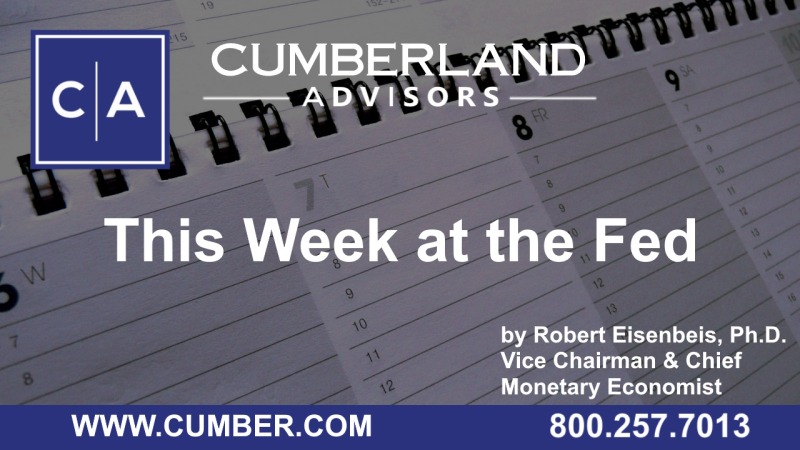Last week saw the FOMC make one-and-one-half decisions on Wednesday, followed two days later with the release of the most recent jobs data. The FOMC raised the target range for its federal funds rate by 25 basis points to 5.00%–5.25%, as expected, and continued winding down the size of its portfolio. The noteworthy change from the Committee’s last statement was the deletion of the phrase that had alluded to possible further increases. The earlier sentence — “The Committee anticipates that some additional policy firming may be appropriate in order to attain a stance of monetary policy that is sufficiently restrictive to return inflation to 2 percent over time” — was replaced with “The Committee will closely monitor incoming information and assess the implications for monetary policy.” While the new language does not formally announce a pause, deleting the reference to further increases (“some additional policy firming”) is all but announcing a pause.

In commenting on the statement at the post-meeting press conference, Chairman Powell was emphatic that the Committee’s goal was to get inflation down to 2.00%. He was also careful to point out, when asked, that a formal pause was not discussed at the meeting as a policy option. However, he did state that the target-rate range was where most of the members felt it should be as the terminal rate consistent with their inflation objectives.
There were three main areas of focus when it came to the questions at the press conference: (a) the financial turmoil and bank failures that have occurred and their implications for financial stability, for changes in bank regulation, and for monetary policy; (b) whether the FOMC still saw that a recession was on the horizon; and (c) whether the FOMC would soon be cutting rates.
Powell asserted that the financial system was sound and that the worst of the liquidity problems faced by regional banks had passed. He did cite evidence that banks were tightening credit standards and cutting back on lending, which he argued put an additional drag on the economy, complementing the Fed’s increase in rates and thus reducing the amount of tightening that might be needed.
One reporter noted that the minutes of the March meeting discussing the staff forecast featured subdued growth and indicated that a mild recession was predicted later in the year, with a recovery in the ensuing two years. The reporter asked whether a recession was still on the horizon. Powell said that forecast would be mentioned in the upcoming minutes, but that it was little changed. However, he went on to indicate that the forecast in question was the staff’s forecast and not that of the Committee members. Most importantly, he stated that it was not his forecast and that he did not necessarily see a recession on the horizon at this time.
Finally, a reporter noted that markets were pricing in rate cuts later this year and questioned whether Powell saw such rate cuts beginning, perhaps, as soon as inflation reached 3%. Powell was emphatic that he saw the need for higher rates for some time and that the target inflation rate was 2% and not 3%.
On Friday after the FOMC meeting, the CES report for April on jobs was released. The April number came in at 253,000, which was greater than economists had expected. (ADP reported on Wednesday that it predicted 296,000 jobs for April.) Little noted was that there were significant downward adjustments to the numbers for February and March. The number for February was revised downward by 78,000 from 326,000 to 248,000. The March number was reduced 71,000 from 236,000 to 165,000. These revised numbers suggested that the labor market was not as strong as it may have appeared to be at the time of the March FOMC meeting, and one wonders whether, if those data had been available for that meeting, the FOMC would have raised rates then and perhaps actually paused in May. The downward revisions also make the April number look even more robust than it appeared at the meeting. Given the timing of key data releases relative to when the FOMC meets, it would seem logical, for example, that the FOMC should have met after the release of the monthly employment data, not before. Timely data is critical to important policy decisions, and the decisions might have been different in March and in May had more timely data been available when the Committee met.
Robert Eisenbeis, Ph.D.
Vice Chairman & Chief Monetary Economist
Email | Bio
Links to other websites or electronic media controlled or offered by Third-Parties (non-affiliates of Cumberland Advisors) are provided only as a reference and courtesy to our users. Cumberland Advisors has no control over such websites, does not recommend or endorse any opinions, ideas, products, information, or content of such sites, and makes no warranties as to the accuracy, completeness, reliability or suitability of their content. Cumberland Advisors hereby disclaims liability for any information, materials, products or services posted or offered at any of the Third-Party websites. The Third-Party may have a privacy and/or security policy different from that of Cumberland Advisors. Therefore, please refer to the specific privacy and security policies of the Third-Party when accessing their websites.
Cumberland Advisors Market Commentaries offer insights and analysis on upcoming, important economic issues that potentially impact global financial markets. Our team shares their thinking on global economic developments, market news and other factors that often influence investment opportunities and strategies.

